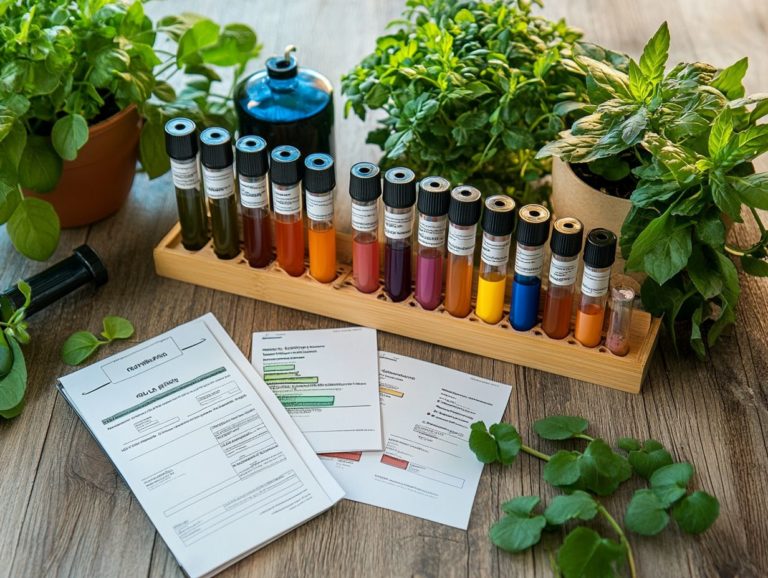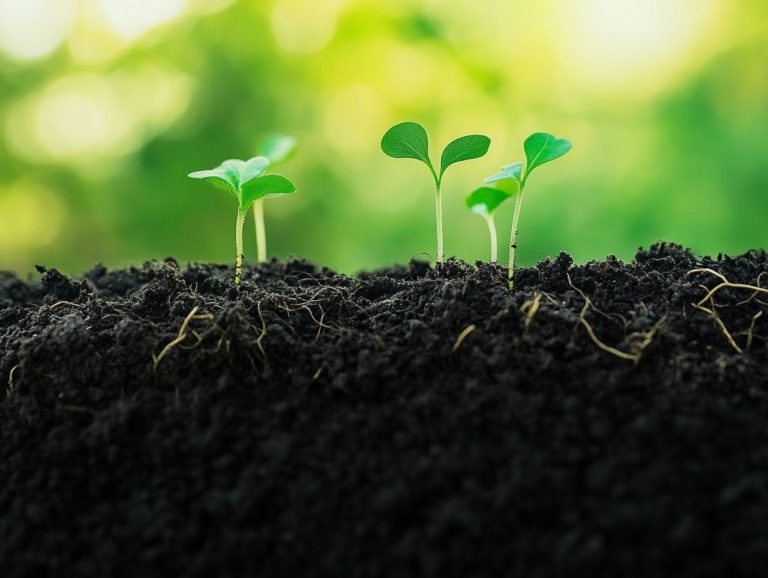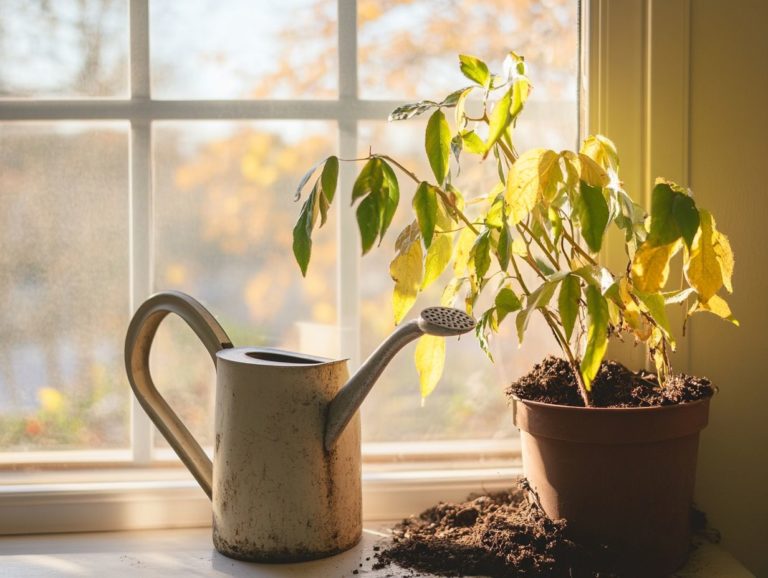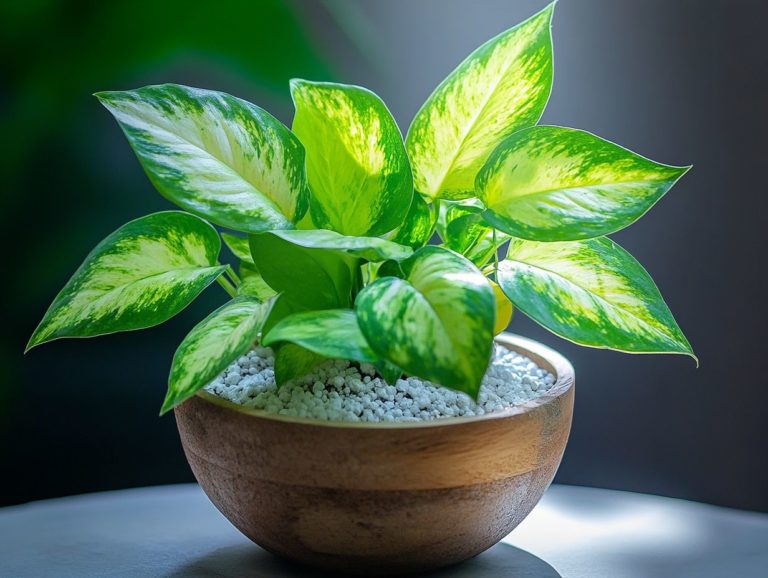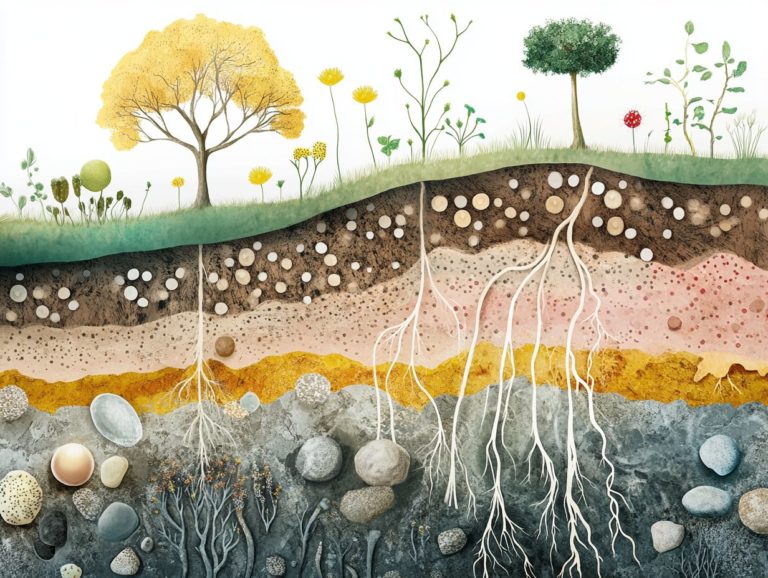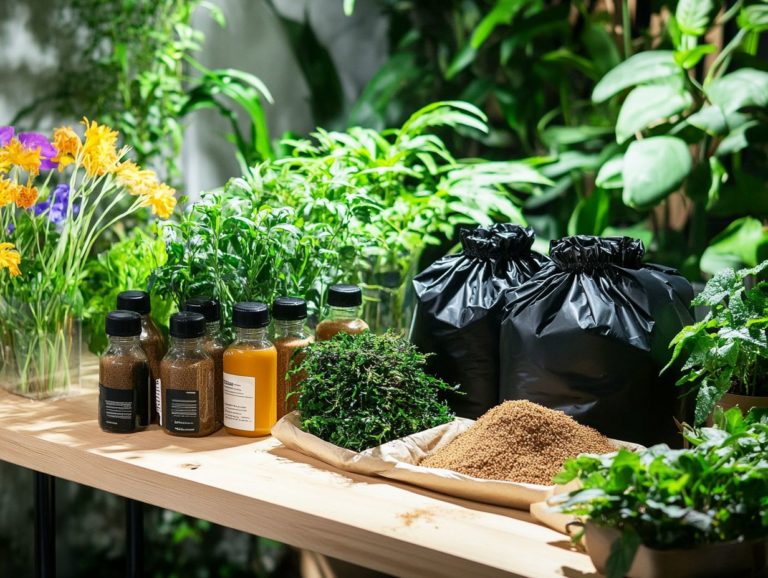Homemade Fertilizer Recipes for Indoor Plants
Indoor gardening is a rewarding pursuit! However, it can be challenging to ensure your plants remain healthy and vibrant.
One effective solution to enhance their growth is to utilize homemade fertilizers made from everyday household items. These natural alternatives are not only eco-friendly but also budget-conscious, delivering essential nutrients without breaking the bank.
Get ready to discover a range of simple yet effective homemade fertilizer recipes! From eggshells to compost tea, these tips will guarantee your indoor plants flourish.
Contents
- Key Takeaways:
- 1. Why Use Homemade Fertilizers for Indoor Plants?
- 2. Common Household Items That Can Be Used as Fertilizers
- 3. Using Eggshells as Fertilizer
- 4. Making Compost Tea for Your Indoor Plants
- 5. Using Coffee Grounds as Fertilizer
- 6. DIY Banana Peel Fertilizer
- 7. How to Make Epsom Salt Fertilizer
- 8. Using Fish Tank Water as Fertilizer
- 9. Making Seaweed Fertilizer at Home
- 10. Using Vegetable Scraps and Kitchen Scraps as Fertilizer
- 11. How to Make Molasses Fertilizer and Homemade Plant Food
- 12. Using Green Tea as Fertilizer and Plant Food Recipe
- 13. DIY Vinegar Fertilizer for Indoor Plants and Plant Care
- 14. Using Grass Clippings and Wood Ash as Fertilizer
- 15. How to Make Homemade Liquid Fertilizer and Nutrient Release
- Frequently Asked Questions About Homemade Fertilizer
- What are some benefits of using homemade fertilizer recipes for indoor gardening?
- How often should I apply homemade fertilizer?
- What common household items can I use to make homemade fertilizer for my indoor plants, such as coffee grounds and eggshells?
- How do I make a basic homemade fertilizer for my indoor plants using Epsom salt?
- Are there different homemade fertilizer recipes for different types of indoor plants?
- Can I use homemade fertilizer recipes for all of my indoor plants while being mindful of nutrient deficiency?
- How often should I use homemade fertilizer on my indoor plants to ensure proper nutrient balance?
Key Takeaways:
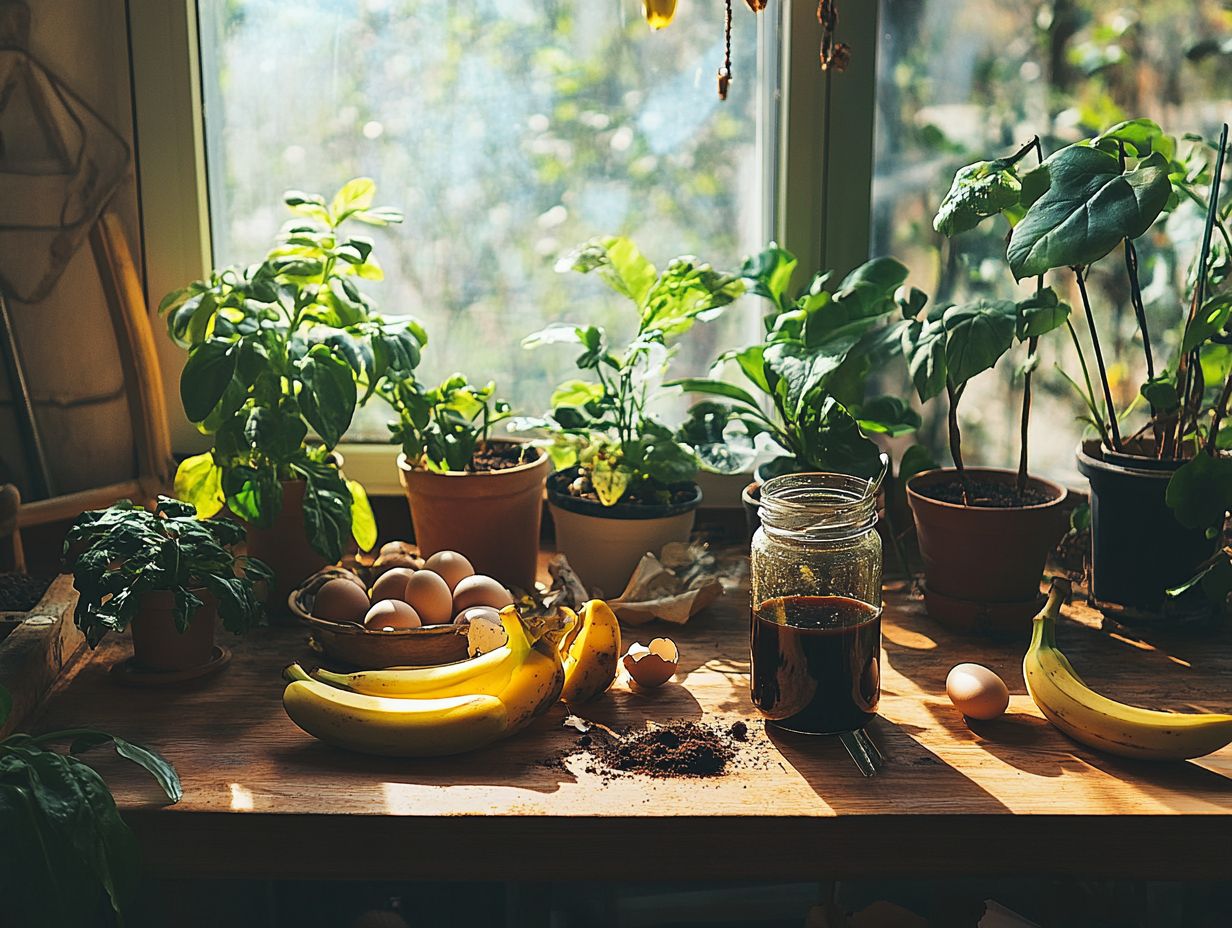
- Save money by using common household items as fertilizers for your indoor plants.
- These homemade fertilizers are eco-friendly and support sustainable gardening.
- Items like eggshells, coffee grounds, and vegetable scraps provide essential nutrients.
1. Why Use Homemade Fertilizers for Indoor Plants?
Homemade fertilizers support strong growth. They also promote a sustainable gardening approach.
By utilizing organic materials like kitchen scraps and compost, you can enhance soil quality while embracing eco-friendly practices.
These natural fertilizers provide your plants with the nourishment they need to thrive. They improve nutrient uptake and minimize waste.
Homemade fertilizers are essential for building nutrient-rich soil. This is vital for plant health.
Regularly enriching the soil with organic matter creates benefits that extend beyond individual plants. They help foster a balanced ecosystem within the potting medium.
This natural approach prevents nutrient deficiencies. It ensures your plants receive adequate nourishment throughout their growth cycles.
Using homemade solutions significantly lowers the risk of nutrient burn, a common problem with commercial fertilizers. This is because homemade fertilizers release nutrients gradually.
By adopting this eco-friendly practice, you not only nurture your plants effectively but also contribute positively to the environment!
2. Common Household Items That Can Be Used as Fertilizers
Numerous household items can enrich your gardening! You can turn kitchen scraps and organic materials into nutrient-rich fertilizers.
Coffee grounds are packed with nitrogen. They make an excellent addition to your compost pile.
Plus, their acidity can work wonders for plants like blueberries. Then there are banana peels, which provide potassium and phosphorus key players in nurturing healthy root development and promoting fruitful yields.
Don t overlook eggshells; they supply calcium. This helps prevent blossom end rot in tomatoes.
Grass clippings are another treasure. They offer a nitrogen boost and serve as mulch to suppress weeds while retaining soil moisture.
Incorporating these items enriches your soil with valuable nutrients. They also introduce beneficial microorganisms that thrive in a healthy ecosystem, setting the stage for your plants to truly flourish.
3. Using Eggshells as Fertilizer
Eggshells are a great source of calcium! They help your indoor plants grow strong and healthy.
Preparing eggshells for fertilizer use is straightforward and effective. First, rinse the shells thoroughly to eliminate any lingering egg white or yolk, as these can attract unwanted pests.
After rinsing, allow them to dry completely. Spread them out on a baking sheet in a sunny spot or pop them in a low-temperature oven for about 10 minutes.
Once they re dry, crush the shells into a fine powder using a blender or food processor. This powdered form enhances the plants’ ability to absorb calcium effectively.
Calcium not only fortifies plant cell walls but also assists in nutrient storage and release. This ensures your plants receive the essential minerals necessary for robust growth!
4. Making Compost Tea for Your Indoor Plants
Compost tea is a nutrient-rich elixir for your plants, created by steeping compost in water. This magical brew harnesses the power of organic materials and beneficial microorganisms to enhance plant health and improve soil quality, especially for your indoor greenery.
The journey begins with selecting high-quality compost that features a variety of inputs think kitchen scraps, yard waste, and aged manure. This variety is like a party for beneficial microbes, setting your plants up for success.
Once you ve chosen the right compost, mix it with water at a ratio of about 1 part compost to 5 parts water. It s best to use non-chlorinated water to protect those precious beneficial microbes.
Next, allow this mixture to aerate for about 24 to 48 hours. This process lets the nutrients seep into the water while encouraging the growth of bacteria and fungi. The benefits of using compost tea are abundant; it gradually releases essential nutrients, feeding your plants over time. At the same time, it enhances overall soil structure and health, creating a thriving ecosystem that can resist pests and diseases. Don t miss out on this easy way to optimize plant growth!
5. Using Coffee Grounds as Fertilizer
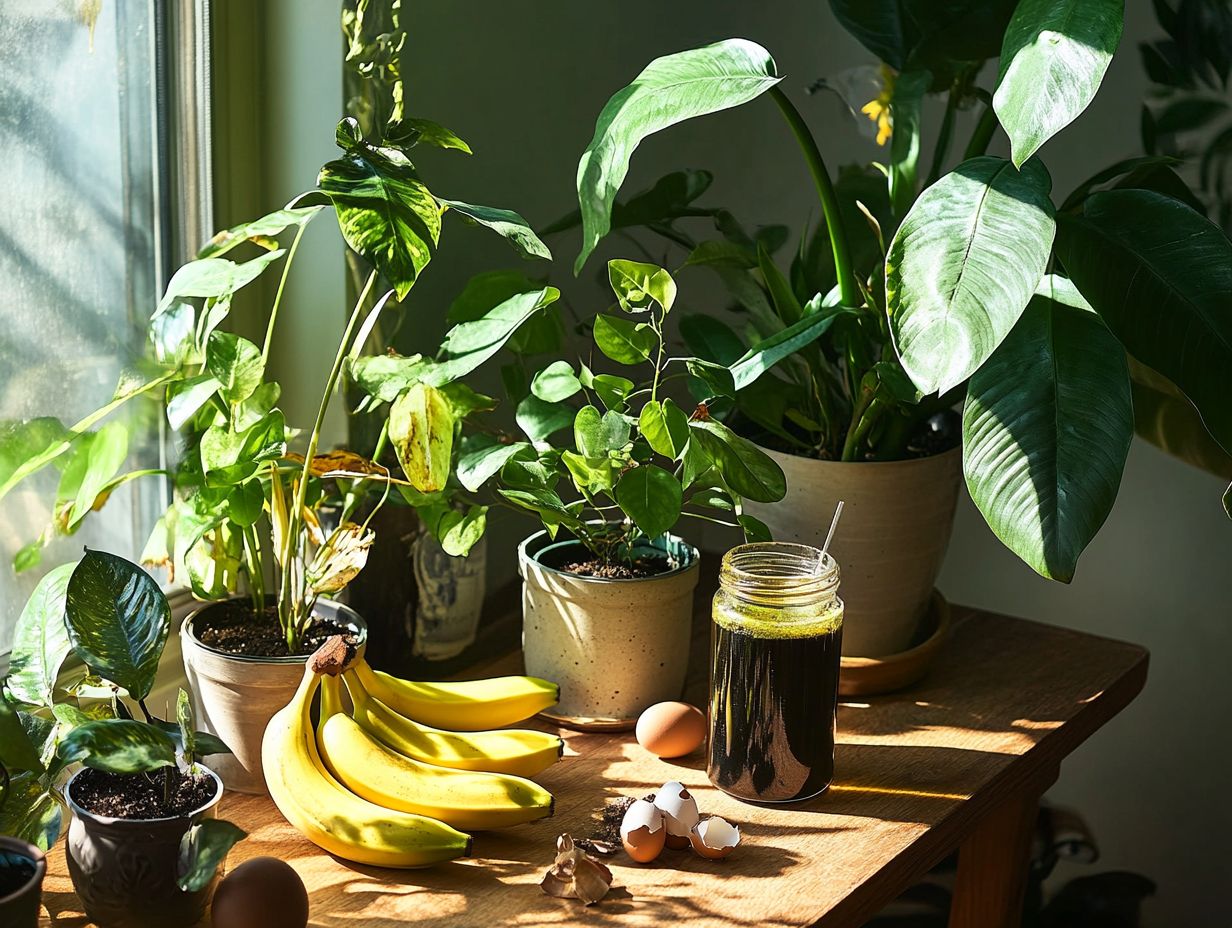
Coffee grounds are an exceptional and sustainable resource for creating homemade fertilizers. Packed with nitrogen, they can significantly improve soil quality and provide essential nutrients for your indoor plants.
By incorporating these grounds into your garden or mixing them with potting soil, you can create a nutrient-rich environment that supports robust growth. Blending coffee grounds into the soil promotes lush, leafy development, while also enhancing the activity of tiny living things in the soil.
This nitrogen boost facilitates improved nutrient uptake, allowing your plants to absorb vital minerals from their surroundings. Coffee grounds also improve soil structure, enhancing drainage and aeration key factors for thriving indoor plants and flourishing outdoor gardens alike.
6. DIY Banana Peel Fertilizer
DIY banana peel fertilizer is a simple and effective way to provide potassium, an essential nutrient for plant growth. This homemade solution can significantly enhance the health of your indoor plants.
This natural approach enriches your soil and promotes optimal nutrient storage and release, leading to robust plant development. One straightforward method involves soaking banana peels in water for a few days to create a nutrient-rich liquid that you can dilute and use to water your plants. For more tips on improving your indoor gardening, check out this guide on how to select the best indoor plant fertilizer.
Alternatively, composting the peels allows for a gradual release of nutrients into the soil, supporting the overall health of your ecosystem. The potassium from the peels helps your plants manage water and nutrients, ensuring they thrive under different conditions and ultimately produce more vibrant foliage and blooms. For those looking to enhance their indoor plant care, exploring the best potting mixes for small indoor plants can also make a significant difference.
7. How to Make Epsom Salt Fertilizer
Epsom salt serves as a valuable source of magnesium, making it a stellar addition to your homemade fertilizers. It can significantly enhance nutrient uptake and improve the overall health of your indoor plants.
To craft an effective Epsom salt fertilizer, simply mix about one to two tablespoons of the salt with a gallon of water. This balanced solution can be applied directly to the soil or used as a foliar spray, enabling your plants to absorb the necessary nutrients more efficiently. For more detailed information, check out our guide on understanding fertilizer labels for indoor plants.
The magnesium in Epsom salt plays a vital role in photosynthesis and aids in the production of chlorophyll, promoting lush, vibrant foliage. By facilitating the absorption of other essential minerals like nitrogen and phosphorus, it helps prevent nutrient deficiencies, ensuring your plants thrive beautifully throughout their growth cycles.
8. Using Fish Tank Water as Fertilizer
Using fish tank water as fertilizer is a clever way to recycle organic materials! It provides your indoor plants with a nutrient-rich solution that encourages healthy growth.
This water is a natural source of essential nutrients, especially nitrogen and phosphorus, which are crucial for plant development. To apply it safely, dilute the fish tank water with fresh water to reduce ammonia levels, which can be harmful in high amounts. For optimal plant health, it’s also important to know how often to fertilize indoor plants. Then, use this nutrient-infused mixture to water your plants.
Not only does this method minimize waste, but it also supports vibrant foliage and blossoms. By incorporating fish tank water into your gardening practices, you create a harmonious cycle of nutrient replenishment, nurturing a healthier environment for both your plants and aquatic life!
9. Making Seaweed Fertilizer at Home
Homemade seaweed fertilizer is your secret weapon an organic powerhouse brimming with essential nutrients that can elevate the health of your indoor plants!
By tapping into the natural benefits of seaweed, you can craft an effective fertilizer that enhances soil quality and delivers vital elements like nitrogen, phosphorus, and potassium. These nutrients are essential for root development, boosting disease resistance, and promoting lush, vibrant foliage. Incorporating organic materials like seaweed significantly improves your soil.
There are several methods to prepare this nutrient-rich elixir. Soaking is a popular choice! Just submerge fresh seaweed in water for a few days, letting the nutrients leach into the liquid. Using cooking water from vegetables can enhance the nutrient profile even further.
Alternatively, boiling seaweed extracts even more nutrients through heat. Whichever method you choose, dilute the resulting fertilizer with water and apply it directly to the soil. Your indoor plants will thrive with this nutrient boost! For added benefits, consider enriching this plant food with top soil amendments for healthy indoor plants like fish emulsion.
10. Using Vegetable Scraps and Kitchen Scraps as Fertilizer

Utilizing vegetable scraps and kitchen scraps as fertilizer is an exceptional way to cultivate a nutrient-rich environment for your indoor plants while embracing sustainable gardening practices!
This approach minimizes waste and enhances soil quality by reintroducing essential nutrients. Common scraps like carrot peels, potato skins, and onion tops are particularly beneficial, packed with vitamins and minerals that contribute to plant growth. How to raise soil fertility for indoor plants involves composting these scraps to create a rich blend that improves soil structure and promotes beneficial microbial activity, vital for healthy plant development.
You might also consider directly burying the scraps in the soil around your plants. This eco-friendly method allows them to decompose naturally, releasing nutrients over time. Simplicity can lead to truly rewarding gardening outcomes while minimizing household waste!
11. How to Make Molasses Fertilizer and Homemade Plant Food
Molasses is a remarkable natural source of sugars that you can easily turn into homemade fertilizer or plant food! This transformation enhances nutrient availability and encourages the flourishing of beneficial microorganisms in your soil.
This organic alternative to synthetic fertilizers is a powerful ally for soil health. It boosts plant vitality and overall plant health.
To prepare your molasses fertilizer, mix one cup of molasses with a gallon of water, stirring until it dissolves completely. Applying it is a breeze; water this mixture into the soil or use it as a foliar spray. For more options, consider the best organic fertilizers for indoor plants. This liquid fertilizer provides a quick source of plant nutrients!
The sugars in molasses act as an energy source for microorganisms, igniting their activity and facilitating the breakdown of organic materials. As these microbes thrive, they help release essential nutrients that your plants can readily absorb, promoting healthier, more robust growth and preventing nutrient deficiency.
12. Using Green Tea as Fertilizer and Plant Food Recipe
Green tea may just surprise you as a remarkable addition to your homemade fertilizers. It offers antioxidants and nutrients that promote robust growth in your indoor plants. By weaving this herbal brew into your gardening routine, you can tap into the strong benefits of green tea’s rich composition, packed with catechins, vitamins, and minerals.
To create a nutrient-rich fertilizer, simply steep used green tea bags or loose leaves in hot water for about 30 minutes. This allows those beneficial compounds to infuse beautifully into the liquid. Once cooled, dilute this tea with water, and use it to hydrate your plants directly or as a foliar spray. For those looking to enhance their indoor plant care, consider the top 10 fertilizers for thriving indoor plants. It’s an effortless, eco-friendly choice!
Using green tea contributes to healthier plants and enhances soil quality over time. This provides a sustainable approach to your organic gardening endeavors.
13. DIY Vinegar Fertilizer for Indoor Plants and Plant Care
DIY vinegar fertilizer presents an elegant solution for providing essential nutrients to your indoor plants while fine-tuning soil acidity for optimal growth, which is crucial for effective plant care.
This homemade remedy leverages the beneficial properties of acetic acid, a natural acid that helps with plant growth, transforming it into an accessible and budget-friendly plant feed. To begin, aim for a dilution ratio of one part vinegar to four parts water. For optimal results, consider understanding how to amend soil for indoor plant growth, as this ensures the mixture is gentle enough to protect delicate roots.
When applied with care, vinegar can effectively lower the soil pH, creating a more acidic environment that enhances nutrient availability. Many plants flourish in slightly acidic conditions, leading to improved nutrient uptake and overall vitality. Therefore, it s crucial to monitor soil pH levels regularly to maintain that ideal balance.
14. Using Grass Clippings and Wood Ash as Fertilizer
Grass clippings and wood ash are readily available organic materials that serve as excellent sources of nitrogen in your homemade fertilizers. This promotes vibrant growth for your indoor plants.
Beyond their role in fertilization, you can use these clippings effectively in your garden beds and around outdoor plants as a rich mulch layer. When applied correctly, they help retain moisture in the soil, suppress weeds, and break down over time to enrich the earth beneath.
As they decompose, they release essential nutrients slowly, making them a perfect addition for both your vegetables and perennial flowers. If you’re looking to enhance soil quality, incorporating grass clippings as mulch not only reduces waste but also fosters a thriving ecosystem in your garden, which is vital for plant health.
15. How to Make Homemade Liquid Fertilizer and Nutrient Release

Creating homemade liquid fertilizer is a straightforward process that enables you to deliver concentrated nutrients directly to your indoor plants. This promotes effective nutrient uptake and fosters healthy growth.
You’ll be amazed at how easy it is to craft nutrient-rich solutions tailored to the specific needs of your plants. Use readily available materials from your kitchen or garden—think kitchen scraps, compost tea, or even grass clippings. Employing various steeping methods can further enhance nutrient extraction; simply let a mixture of water and organic matter brew for several days to yield a potent tonic. For more detailed guidance, check out how to fertilize your indoor plants effectively.
When it comes time to apply this vibrant liquid fertilizer, timing is key. Aim to do this during the active growing season and ensure even distribution around the base of your plants. This approach maximizes nutrient absorption while helping you avoid the dreaded root burn.
Frequently Asked Questions About Homemade Fertilizer
What are some benefits of using homemade fertilizer recipes for indoor gardening?
Homemade fertilizer recipes for indoor plants are cost-effective, environmentally friendly, and customizable to your plant’s specific needs. They provide crucial nutrients and promote healthy growth and blooming.
How often should I apply homemade fertilizer?
It’s best to apply homemade fertilizer every 4-6 weeks during the growing season to keep your plants thriving!
Start your homemade fertilizer journey today and watch your indoor garden flourish!
What common household items can I use to make homemade fertilizer for my indoor plants, such as coffee grounds and eggshells?
You can use items like coffee grounds, eggshells, banana peels, and vegetable scraps. These items are easy to find and can be added to your homemade fertilizer.
How do I make a basic homemade fertilizer for my indoor plants using Epsom salt?
A simple recipe involves mixing equal parts of water and compost or manure. This mixture nourishes your plants weekly. Add molasses or seaweed for extra nutrients!
Are there different homemade fertilizer recipes for different types of indoor plants?
Yes, different indoor plants have specific nutrient needs. For example, acidic-loving plants thrive with coffee grounds, while nitrogen-hungry plants benefit from banana peels.
Can I use homemade fertilizer recipes for all of my indoor plants while being mindful of nutrient deficiency?
Absolutely! Most indoor plants can use these recipes. Just research your plant’s needs and adjust the ingredients as necessary.
How often should I use homemade fertilizer on my indoor plants to ensure proper nutrient balance?
Regularly fertilizing your plants helps them thrive. Fertilize once a week or every other week, but keep an eye on your plants health to make adjustments!

